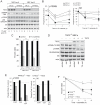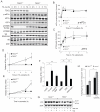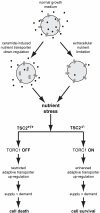Loss of TSC2 confers resistance to ceramide and nutrient deprivation
- PMID: 23604129
- PMCID: PMC3858574
- DOI: 10.1038/onc.2013.139
Loss of TSC2 confers resistance to ceramide and nutrient deprivation
Abstract
Nutrient stress that produces quiescence and catabolism in normal cells is lethal to cancer cells, because oncogenic mutations constitutively drive anabolism. One driver of biosynthesis in cancer cells is the mammalian target of rapamycin complex 1 (mTORC1) signaling complex. Activating mTORC1 by deleting its negative regulator tuberous sclerosis complex 2 (TSC2) leads to hypersensitivity to glucose deprivation. We have previously shown that ceramide kills cells in part by triggering nutrient transporter loss and restricting access to extracellular amino acids and glucose, suggesting that TSC2-deficient cells would be hypersensitive to ceramide. However, murine embryonic fibroblasts (MEFs) lacking TSC2 were highly resistant to ceramide-induced death. Consistent with the observation that ceramide limits access to both amino acids and glucose, TSC2(-/-) MEFs also had a survival advantage when extracellular amino acids and glucose were both reduced. As TSC2(-/-) MEFs were resistant to nutrient stress despite sustained mTORC1 activity, we assessed whether mTORC1 signaling might be beneficial under these conditions. In low amino acid and glucose medium, and following ceramide-induced nutrient transporter loss, elevated mTORC1 activity significantly enhanced the adaptive upregulation of new transporter proteins for amino acids and glucose. Strikingly, the introduction of oncogenic Ras abrogated the survival advantage of TSC2(-/-) MEFs upon ceramide treatment most likely by increasing nutrient demand. These results suggest that, in the absence of oncogene-driven biosynthetic demand, mTORC1-dependent translation facilitates the adaptive cellular response to nutrient stress.
Figures








Similar articles
-
Tumor suppressors TSC1 and TSC2 differentially modulate actin cytoskeleton and motility of mouse embryonic fibroblasts.PLoS One. 2014 Oct 31;9(10):e111476. doi: 10.1371/journal.pone.0111476. eCollection 2014. PLoS One. 2014. PMID: 25360538 Free PMC article.
-
Estradiol promotes pentose phosphate pathway addiction and cell survival via reactivation of Akt in mTORC1 hyperactive cells.Cell Death Dis. 2014 May 15;5(5):e1231. doi: 10.1038/cddis.2014.204. Cell Death Dis. 2014. PMID: 24832603 Free PMC article.
-
mTORC1 hyperactivity inhibits serum deprivation-induced apoptosis via increased hexokinase II and GLUT1 expression, sustained Mcl-1 expression, and glycogen synthase kinase 3beta inhibition.Mol Cell Biol. 2009 Sep;29(18):5136-47. doi: 10.1128/MCB.01946-08. Epub 2009 Jul 20. Mol Cell Biol. 2009. PMID: 19620286 Free PMC article.
-
Mourning Dr. Alfred G. Knudson: the two-hit hypothesis, tumor suppressor genes, and the tuberous sclerosis complex.Cancer Sci. 2017 Jan;108(1):5-11. doi: 10.1111/cas.13116. Epub 2017 Jan 23. Cancer Sci. 2017. PMID: 27862655 Free PMC article. Review.
-
Signal integration by mTORC1 coordinates nutrient input with biosynthetic output.Nat Cell Biol. 2013 Jun;15(6):555-64. doi: 10.1038/ncb2763. Nat Cell Biol. 2013. PMID: 23728461 Free PMC article. Review.
Cited by
-
Dihydroceramide desaturase 1 (DES1) promotes anchorage-independent survival downstream of HER2-driven glucose uptake and metabolism.FASEB J. 2022 Oct;36(10):e22558. doi: 10.1096/fj.202200748R. FASEB J. 2022. PMID: 36165222 Free PMC article.
-
Dynamic analysis of 4E-BP1 phosphorylation in neurons with Tsc2 or Depdc5 knockout.Exp Neurol. 2020 Dec;334:113432. doi: 10.1016/j.expneurol.2020.113432. Epub 2020 Aug 8. Exp Neurol. 2020. PMID: 32781001 Free PMC article.
-
Dynamic Phosphoproteomics Uncovers Signaling Pathways Modulated by Anti-oncogenic Sphingolipid Analogs.Mol Cell Proteomics. 2019 Mar;18(3):408-422. doi: 10.1074/mcp.RA118.001053. Epub 2018 Nov 27. Mol Cell Proteomics. 2019. PMID: 30482847 Free PMC article.
-
A Ceramide-Regulated Element in the Late Endosomal Protein LAPTM4B Controls Amino Acid Transporter Interaction.ACS Cent Sci. 2018 May 23;4(5):548-558. doi: 10.1021/acscentsci.7b00582. Epub 2018 May 9. ACS Cent Sci. 2018. PMID: 29806001 Free PMC article.
-
PCK2 activation mediates an adaptive response to glucose depletion in lung cancer.Oncogene. 2015 Feb 19;34(8):1044-50. doi: 10.1038/onc.2014.47. Epub 2014 Mar 17. Oncogene. 2015. PMID: 24632615
References
-
- Dazert E, Hall MN. mTOR signaling in disease. Curr Opin Cell Biol. 2011;23:744–55. - PubMed
-
- Yecies JL, Manning BD. mTOR links oncogenic signaling to tumor cell metabolism. Journal of molecular medicine. 2011;89:221–8. - PubMed
-
- Curatolo P, Bombardieri R, Jozwiak S. Tuberous sclerosis. Lancet. 2008;372:657–68. - PubMed
Publication types
MeSH terms
Substances
Grants and funding
LinkOut - more resources
Full Text Sources
Other Literature Sources
Molecular Biology Databases
Research Materials

